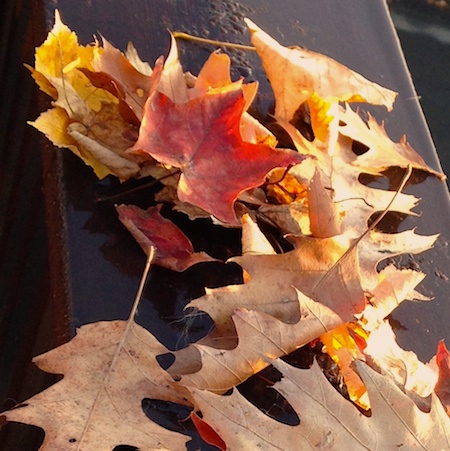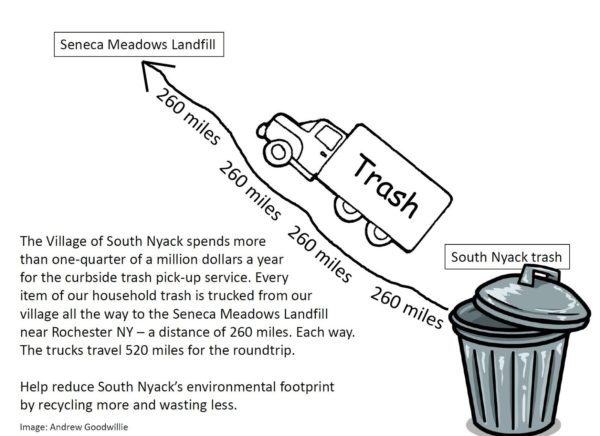by Marcy Denker
 Earth Matters focuses on conservation, sustainability, recycling and healthy living.
Earth Matters focuses on conservation, sustainability, recycling and healthy living.
If Earth Matters to you, sign up for our mailing list and get the next installment delivered right to your inbox.
Rake them up and burn them was once how we regarded our leaves in autumn. Then blowing, piling, and bagging became the norm. Now more homeowners (and municipalities too!) see fall leaves as a valuable resource that can be used on site instead of as an expensive burden to be hauled away. In fact, leaves can be the secret ingredient in a strategy to substantially lower the financial and environmental costs of managing our waste overall.
So what is best: to mulch leaves, compost them, move them around, or let them be? If you want to make the most of them, it will be a combination of methods to support a healthy landscape, save money, and keep things looking good.
Enhancing Your Garden Habitats
If you’ve been thinking that a clean and tidy garden bed is a healthy one, think again. Just as in the forest, fallen leaves nourish the soil as they break down and support the pollinators, butterflies, beneficial insects, and small vertebrates that are the sign of a truly healthy garden.
 And considering the drastic declines in many species that were once abundant in local yards, the best option is to leave winter cover in the form of whole leaves and standing dead plant material. Whole leaves provide more cover for these beneficial critters than mulched ones, so leave the leaves on the beds to do the most for the wildlife in your yard. And if you need to clean them up in spring, just wait until the middle of the season so insects have a chance to emerge from hibernation.
And considering the drastic declines in many species that were once abundant in local yards, the best option is to leave winter cover in the form of whole leaves and standing dead plant material. Whole leaves provide more cover for these beneficial critters than mulched ones, so leave the leaves on the beds to do the most for the wildlife in your yard. And if you need to clean them up in spring, just wait until the middle of the season so insects have a chance to emerge from hibernation.
But isn’t it a mess? Taking this approach may mean a shift in thinking and seeing. We may tolerate a less tidy look in our garden beds as we come to appreciate the hidden life of the winter landscape. But we can still keep the lawns and edges tidy by regular mulch mowing through the fall season–preferably with an electric mower rather than a gas powered one.
The Compost Pile

Photo courtesy LELENY
While it’s true that you can mulch-mow the leaves all across the lawn, you can also save some for the compost pile. If food scraps in your house get tossed into the compost, you know the importance of having lots of dry material (known as browns) that nicely balance out the wet material (or greens). The dry leaves provide energy in the form of carbon, and absorb excess moisture of the food scraps. The more food scraps you generate the more likely you’ll covet those magical browns in your neighbor’s yard.
Layered compost pile with food scraps and leaves. Photo from Cornell Cooperative Extension Waste Management Institute’s Guide to Composting at Home.
The Financial and Environmental Costs
 Keeping a compost pile where you recycle food waste instead of throwing it out really is about more than making that miraculous material to enrich and balance the soil. It’s about keeping food scraps out of the waste stream–again reducing trucking costs and fuel use–and more importantly, reducing methane emissions from landfills. Food waste makes up approximately 22% of our household garbage, and all of our garbage is trucked out of Rockland 260 miles to a landfill in Ontario County. Widespread leaf and food scrap composting can really reduce those loads. And that would help local budgets. Even a small community like South Nyack spends more than a quarter million dollars on hauling garbage each year.
Keeping a compost pile where you recycle food waste instead of throwing it out really is about more than making that miraculous material to enrich and balance the soil. It’s about keeping food scraps out of the waste stream–again reducing trucking costs and fuel use–and more importantly, reducing methane emissions from landfills. Food waste makes up approximately 22% of our household garbage, and all of our garbage is trucked out of Rockland 260 miles to a landfill in Ontario County. Widespread leaf and food scrap composting can really reduce those loads. And that would help local budgets. Even a small community like South Nyack spends more than a quarter million dollars on hauling garbage each year.
Apart from that, our municipal leaf pick up programs have a steep price tag. Nyack spends roughly $40,000 in village worker hours devoted for leaf collection every fall that could be used instead for critical infrastructure maintenance and repair. (The actual total cost of leaf collection includes fuel, transportation, special equipment costs, and prevention of storm drain clogging.) Right now, the Town of Orangetown is cutting back on its leaf program due to budget constraints. And the Superintendent of Highways is advocating reallocating funds to avoid a severe reduction of services. So, yes, the leaves hauled to municipal facilities are made into compost that is available to residents; however, keeping leaves in our own yards can improve the lawn and garden and reduce the cost of trucking the leaves away.
Homeowners who take a sustainable approach to landscape and household management want all 3 methods–a little mulch mowing for keeping things tidy, piling up whole leaves for a well-balanced compost bin that includes food scraps, and leaving leaves alone in planting beds for the insects and pollinators we want our gardens to support. It just takes a little planning.
A local group of citizen volunteers, Rockland Composters, has organized to promote backyard composting and a municipal food scrap composting. For information contact rocklandcomposters@gmail.com .
Marcy Denker is a landscape designer, Chair of the Nyack Tree Committee, Sustainability Coordinator for the Village of Nyack, and Co-Chair of Rockland Composters.
See also:
- Love ‘Em and Leave ‘Em
- Nyack Pollinator Pathway
- Ecological Landscape Alliance
- Cornell Cooperative Extension of Rockland Composing Resources
Read Earth Matters every Wednesday on Nyack News And Views, or sign up for the Earth Matters mailing list.








